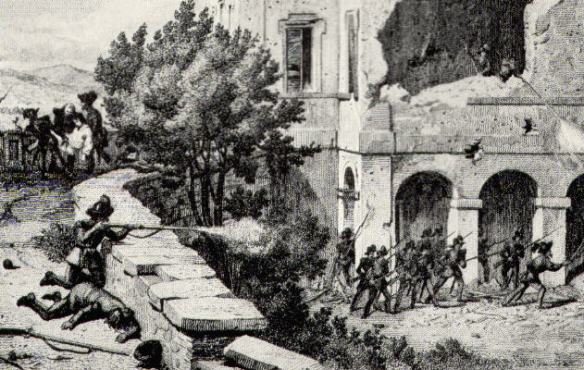The last resistance of the Bersaglieri at Villa Spada
(engraving by Carlo Werner)
When a Republic was declared in Rome, France sent 8,000 troops under General Charles Oudinot to besiege the city, which was held by 20,000 men, including 5,000 followers of Giuseppe Garibaldi. After an initial repulse, and a second reinforced attack driven off a month later, Oudinot eventually forced the city to capitulate. Garibaldi fled to America (30 April-2 July 1849).
Pius IX became Pope in 1846. He began his reign by an attempt to introduce reforms into his government, and took measures to establish a system of popular representation. The overthrow of Louis Philippe, in France, in 1848, excited the hopes of the revolutionary party throughout Italy, and the pope hesitated to grant the full measure of popular privileges demanded by his subjects. The character of Pius IX has been variously estimated. It passed through more than one phase; and, while retaining certain leading qualities throughout, it was wanting in consistency. The abrupt change in his policy after 1848 gave the impression that Pius IX was a Liberal before, and a reactionary after, that date. It may be doubted whether he was ever by conviction either the one or the other. He had the obstinacy of a weak man. A man of sentiment rather than of fact, he moved in a world of signs and wonders: his credulity was abnormal, and his piety, sincere as it was, stood in no relation to the mind or facts of his time. He magnified his office; and, regarding opposition to his will as the unpardonable.
At his accession the government of the Papal States was, with the possible exception of the kingdom of Naples, the worst in Italy. Every public department was in disorder. The finances were desperate; taxation was heavy and unequal; trade was limited to small industries; manufactures did not exist. The higher posts in the administration were open only to the clergy; the police, whose number was out of all proportion to the population, were employed mainly for political purposes; smuggling and brigandage were rife. Railways were forbidden; education was nominal and difficult of access; the mental and moral life of the people was deliberately stunted.
The people, ignorant and untrained in the duties of citizenship, got out of hand; and the murder of the Minister Rossi, a doctrinaire Liberal, closed the first chapter of the pontificate. On the morning of November 15, 1848, Rossi drove to the Palace of the Cancelleria for the purpose of opening Parliament; after leaving his carriage and ascending the first few steps of the staircase, he met his death at the hand of an assassin. On the day after the death of Rossi, a popular insurrection forced the Pope to call a Democratic Ministry under Monsignor Carlo Muzzarelli, of which Pietro Sterbini, one of the instigators of the murder, was a member. On November 25 the Pope fled from Rome and took refuge at the Neapolitan fortress of Gaeta. Here his vacillation ceased; henceforward he stood for the lost cause of European reaction. Irritated by the clemency of the French to his revolted subjects, Pius IX leaned on Austrian protection. He issued a Commission of Regency; but his Commissioners were unable to act, or even to meet.
The Chambers replied by the appointment of a “Supreme Committee of State,” which decided to proceed to the election of a Constituent Assembly by universal suffrage. This Assembly met on February 5, 1849, on the 9th proclaimed a Republic, and organized a government under three triumvirs.
France, Republican France, in whom Mazzini trusted so confidently, offered the Pope her intervention in Rome, on condition that she should act alone; and on April 25, 1849, a French force under Oudinot landed at Civita Vecchia on its way to Rome. The French, who had not expected any serious resistance in Rome, were soon undeceived. On April 30, 1849, Garibaldi repulsed them by sheer hard fighting; and he similarly drove back the Neapolitans on May 19. French General Charles Oudinot concealed the extent of his defeat, and sent home for reinforcements. Thus between France and the Roman Republic there suddenly arose a question of military amour proper obscuring the political issues; and this just at the moment when the President of the French Republic, for the confirmation of his own power and for the eventual restoration of the Empire, needed the whole support both of the army and the Church.
In order to gain time, the French sent Ferdinand de Lesseps to Rome to treat for peace with Mazzini and the Assembly; and on May 17 an armistice was concluded. Lesseps no doubt acted in good faith, as did Mazzini; and they came to terms. But, as soon as the reactionary intrigues between Gaeta and the French headquarters were ripe, and the reinforcements had arrived, the terms were repudiated. Without even giving notice of the close of the armistice, the French suddenly assaulted Rome. Garibaldi and his forces made a heroic stand; but on June 30, they were obliged to abandon the defence, and a number retreated with Garibaldi before the French entered the city. The life of the ill-starred Roman Republic ‘ under Mazzini had been precarious and, politically speaking, it earned small praise; but, as the death-struggle of Italians against foreign perfidy and violence, its record is glorious and its memory is still green.
The French took possession of Rome, and the authority of the pope was restored. He re-entered his capital, April 12, 1850, where, supported (except for a brief interval) by French bayonets, he reigned for twenty years. Laymen were again excluded from office; the electoral bodies were not even convened; in 1851, the number of political prisoners reached 8800; the vendetta pretina was in full swing.
